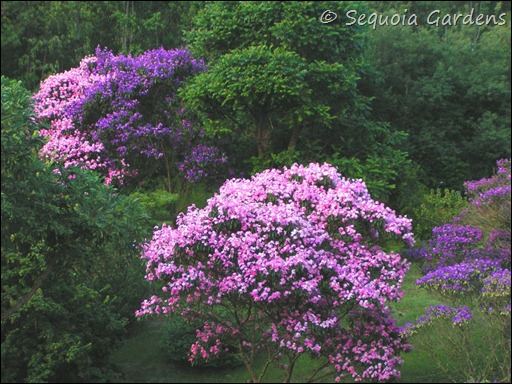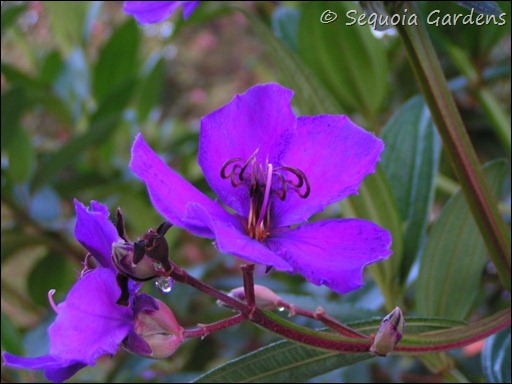Growing wild on Sequoia you will find this remarkable colour combination: a flower of the most vivid magenta held in luminescent brick-red cups. Startling it is, and beautiful. The Wild Tibouchina, Dissotis canescens, is well named, for the intensity of its petal colour is very similar to the real Tiboushina. Indeed, they both belong to the family MELASTOMATACEAE, but that is as far as I can comment, for unlike something like the BEGONIACEAE where I can nod along sagely and say “A, yes, the Begonia family” and at least have a picture in my head, the family MELASTOMATACEAE contains only two names I’ve ever heard before: Dissotis and Tibouchina. Perhaps there is a path worth following here, for I suspect I will stumble upon a garden of tropical magnificence… Ah yes. And then not be able to grow it… Below are pictures I took in a nearby sub-tropical garden of the two colour forms of one of the most spectacular of all flowering trees: the Brazilian Tibouchina granulosa.
The pink can be dismissed as ‘just a pink’, but the purple is more than purple: it is as though the richest red chiffon has been overlaid with the richest blue, and the two colours jar and shimmer in forming purple.
Compared to these magnificent trees, my little perennials are slight. But a few years back I spread seed in the boggy ground around the water of Freddie’s Dam, which they love, and this summer saw thirty or more plants in flower – and each year there will now be more. We are moving from a local who hid away from visitors, to one of the stars of our show.
Close-ups, above of our Dissotis and below of the much larger flower of Tibouchina granulosa again make their relationship clear.
To see more wild flowers from around the world, visit the blogs participating every month in Wild Flower Wednesday, an event started by Gail of Clay and Limestone.







What an absolute beauty! Then, there’s the cousin another stunning looker! I love how magnificently Mother nature paints her flowers and the color combinations. Thank you for sharing. gail
I knew for 10 days, Gail, that this was my WFW entry! Thanks for stopping by.
That’s a blossom I’m not familiar with, but my it’s beautiful!
This plant is so beautiful! I have not seen it before. I grow Princess Flower (T. urvilleana) which is also very colorful in a bright tropical way, and I believe, the most common of Tibouchinas. Thank you for showing this wonderful shrub.
Hello again Masha!
T. urvilleana grows in my garden too. I have one shrub that -literally – manages one flower every second year before the frost cuts it down. However I propagated it from cuttings and currently, a good 8 weeks before the first frost could possibly be expexted, there are 3 plants in flower in my nursery. Ergo, find a better spot for it! I am going to plant them up against the west facing wall of the big house within the next few weeks! In fact i aught to do a follow-up post on them: thanks for the reminder!
M Melastomataceae? Magnificent ;~)
Didn’t know what you meant, Diana… then I went back to check, for I’d realised that I’d called them genus instead of family Mela-etc. And discovered I’d called them Bela-etc. Perhaps because I was referring to the Bignonias? Perhaps because I thought they were pretty? Anyway: thank you for pointing out that I had it wrong! 😉
Beautiful color! Your wildflowers are the same as the trees? Somehow the flowers don’t look the same. I liken those large blossoms of the tree to the individual blossom on Phlox paniculata. Very, Very pretty! All of them!
Hi, Shady Gardener, and welcome to my blog! In their velvety texture and saturated colour, as well as their structure, they are very similar. And although the wild flower’s flowers are not much bigger than phlox, the tree’s flowers are 3 or 4 in. in diameter. I’ll be doing a follow-up post later today!
What takes my breath away is the combination of the magenta petals and the blue stamens on this flower.
I’ve been doing some more reading, Jean, and I think a follow-up is called for, for it seems the chief quality of Melastomataceae is saturated colour…
Pingback: SNAPSHOTS FROM A CELEBRATORY WALK « Sequoia Gardens Blog
Pingback: A BIT OF BOTANISING « Sequoia Gardens Blog
Pingback: I DON’T WANT MUCH, I JUST WANT MORE « Sequoia Gardens Blog